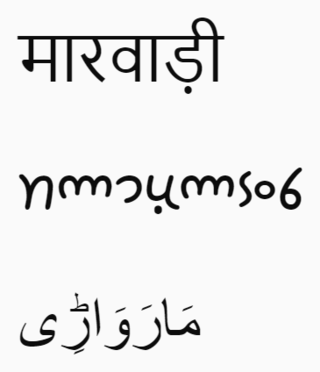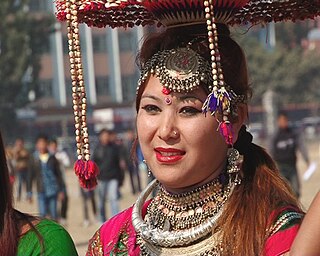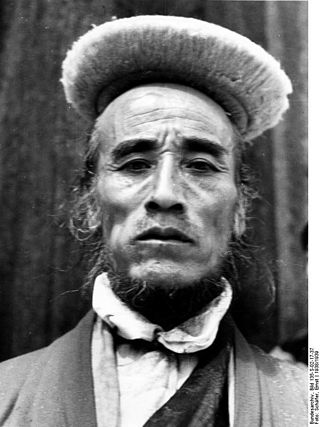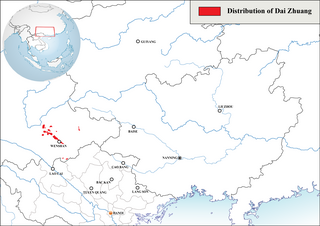Related Research Articles
Bihari languages are a group of the Indo-Aryan languages. The Bihari languages are mainly spoken in the Indian states of Bihar, Jharkhand, Uttar Pradesh, and West Bengal, and also in Nepal. The most widely spoken languages of the Bihari group are Bhojpuri, Magahi and Maithili.

Marwari is a language within the Rajasthani language family of the Indo-Aryan languages. Marwari and its closely related varieties like Dhundhari, Shekhawati and Mewari form a part of the broader Marwari language family. It is spoken in the Indian state of Rajasthan, as well as the neighbouring states of Gujarat and Haryana, some adjacent areas in eastern parts of Pakistan, and some migrant communities in Nepal. There are two dozen varieties of Marwari. Marwari is also referred to as simply Rajasthani.

The Tharu people are an ethnic group indigenous to the Terai in southern Nepal and northern India. They speak Tharu languages. They are recognized as an official nationality by the Government of Nepal. In the Indian Terai, they live foremost in Uttarakhand, Uttar Pradesh and Bihar. The Government of India recognizes the Tharu people as a scheduled Indian tribe.

Bhotiya or Bhot is an Indian and Nepali exonym lumping together various ethnic groups speaking Tibetic languages, as well as some groups speaking other Tibeto-Burman languages living in the Transhimalayan region that divides India from Tibet. The word Bhotiya comes from the classical Tibetan name for Tibet, བོད, bod. The Bhotiya speak numerous languages including Ladakhi. The Indian recognition of such language is Bhoti / Bhotia having Tibetan scripts and it lies in the Parliament of India to become one of the official languages through Eighth Schedule of the Indian Constitution.

Tamang is a term used to collectively refer to a dialect cluster spoken mainly in Nepal, Sikkim, West Bengal (Darjeeling) and North-Eastern India. It comprises Eastern Tamang, Northwestern Tamang, Southwestern Tamang, Eastern Gorkha Tamang, and Western Tamang. Lexical similarity between Eastern Tamang and other Tamang languages varies between 81% and 63%. For comparison, the lexical similarity between Spanish and Portuguese is estimated at 89%.
Madheshi people is a term used for Nepalis comprising several ethnic groups living in the Madhesh Province, and the Terai region of Koshi Province and Lumbini Province. It has also been used as a political pejorative term by the Pahari people of Nepal to refer to Neapalese with a non-Nepali language as their mother tongue, regardless of their place of birth or residence. The term Madheshi became a widely recognised name for people of Madhesh but it has also been used for people with an Indian cultural background married to Madhesis only after 1990. Madheshi people comprise various cultural groups such as Hindus, Muslims, Marwaris, Brahmin and Dalit caste groups as well as Nepalese ethnic groups like Maithils, Bhojpuri, Awadhi and Bajjika speaking people and the native indigenous people of Madhesh. In recent times, government papers, some politicians and journalists use the term for all Nepalis living in southern Nepal.

Spanish is the language that is predominantly understood and spoken as a first or second language by nearly all of the population of Argentina. According to the latest estimations, the population is currently greater than 45 million.

South Asia is home to several hundred languages, spanning the countries of Afghanistan, Bangladesh, Bhutan, India, Maldives, Nepal, Pakistan, and Sri Lanka. It is home to the fourth most spoken language in the world, Hindi–Urdu; and the sixth most spoken language, Bengali. Languages like Bengali, Tamil and Nepali have official/national status in more than one country of this region. The languages in the region mostly comprise Indo-Iranic and Dravidian languages, and further members of other language families like Austroasiatic, and Tibeto-Burman languages.

The Tharu or Tharuhat languages are any of the Indo-Aryan languages spoken by the Tharu people of the Terai region in Nepal, and neighboring regions of Uttarakhand, Uttar Pradesh and Bihar in India.

The Eastern Indo-Aryan languages, also known as Māgadhan languages, are spoken throughout the eastern region of the Indian subcontinent, which includes Bihar, Uttar Pradesh, Jharkhand, Bengal region, Tripura, Assam, and Odisha; alongside other regions surrounding the northeastern Himalayan corridor. Bengali is official language of Bangladesh and the state of West Bengal, Tripura and the Barak valley of Assam while Assamese and Odia are the official languages of Assam and Odisha, respectively. The Eastern Indo-Aryan languages descend from Abahattha, which descends from Magadhan Apabhraṃśa and ultimately from Magadhi Prakrit.

Dai Zhuang or Thu Lao is a Tai language spoken in Yunnan, China and northern Vietnam. In China is it spoken in Yanshan, Wenshan, Maguan, Malipo, Guangnan counties of Wenshan Prefecture. It is also spoken in Honghe Prefecture. The largest concentrations are in Wenshan and Yanshan counties.
Most of the languages of Bihar, the third most populous state of India, belong to the Bihari subgroup of the Indo-Aryan family. Chief among them are Bhojpuri, spoken in the west of the state, Maithili in the north, Magahi in center around capital Patna and in the south of the state. Maithili has official recognition under the Eighth Schedule to the Constitution of India. The official language of Bihar is Modern Standard Hindi, with Standard Urdu serving as a second official language in 15 districts.
Mewahang (Meohang), or Newahang, is a Kiranti language spoken in Nepal. The eastern and western dialects are structurally distinct.
Lampucchwa Tharu or Morangiya Tharu is one of the endogamous subgroups of Tharu people which are an ethnic group indigenous to the Terai, the southern foothills of the Himalayas in Nepal and India. Likewise Morangiya Tharu dwells in the Eastern plain or Terai of Nepal. They can be found mainly in the districts of Morang and Sunsari. Though found in two districts, they are called by Morangiya Tharu as those two districts were one district before 1962. Within the group, they refer to themselves as Morangiya Tharu, but people from other regions would call them Lampucchwa.

Madhesh Province is a province of Nepal in the Terai region with an area of 9,661 km2 (3,730 sq mi) covering about 6.5% of the country's total area. It has a population of 6,126,288 as per the 2021 Nepal census, making it Nepal's most densely populated province and the smallest province by area. It borders Koshi Pradesh to the east and the north, Bagmati Province to the north, and India’s Bihar state to the south and the west. The border between Chitwan National Park and Parsa National Park acts as the provincial boundary in the west, and the Kosi River forms the provincial border in the east. The province includes eight districts, from Parsa in the west to Saptari in the east.

Kumal is a caste or ethnic group in Nepal, traditionally associated with pottery. Their traditional profession is endangered due to competition from cheaper, more durable industrial pots. Fewer youths learn the skills. They are found to inhabit in the Terai, inner Terai and Mid-hills close to the riverbanks where bioresearches are rich to continue to their traditional occupation. Their traditional dance, the Pangdure, is considered endangered.
Danguara Tharu also known as Dangauli Tharu, Dangora Tharu, or Dangura Tharu is one of the Tharu languages spoken by the Tharu people in the Dang, Kapilvastu, Banke, and Bardiya districts of the Lumbini Province and in Kailali and Kanchanpur district of Sudurpaschim Province of Nepal, primarily in the Western Terai Region as well as in Bahraich, Gorakhpur, and Lakhimpur Kheri districts of Uttar Pradesh in India.
Kathariya Tharu also known as Kathoriya Tharu is one of the Indo Aryan languages spoken by the Tharu people of Nepal and India. It is a language spoken in the Sudurpashchim Province of Nepal, particularly in the Kailali District, including areas like Bardagoriya, Bhajani, Ghodaghodi, Joshipur. Additionally, it is spoken in the Uttar Pradesh state of India, specifically in Bahraich and Lakhimpur Kheri districts near the Nepal border.
Rana Tharu is a Indo Aryan language spoken by the Rana Tharu people who are part of the Tharu ethnic group in the Sudurpashchim Province of Nepal, specifically in the Kanchanpur district's southern municipalities and Dhangadhi in the Kailali district. Rana Tharu is also spoken in specific areas of Uttar Pradesh, India including the Lakhimpur Kheri district, particularly in Palia Kalan and Chandan Chauki block, situated on the India–Nepal border. Additionally, it is spoken in the Udham Singh Nagar district of Uttarakhand state. It exhibits high intelligibility among its dialects, with reported percentages ranging from 96% to 99%. The language has linguistic distinctions with dialects in India and shows lexical similarities with Awadhi and Buksa as well.
The Sonha language also known as Sonaha, Sunha, or Sunah is an Indo-Aryan language spoken by the Sonha people in Lumbini Province, specifically in Bardiya District, covering Geruwa and Rajapur municipalities. It is also spoken in Sudurpashchim Province, particularly in Kanchanpur District and Bhimdatta of Nepal. Sonha exhibits linguistic similarities with Awadhi, with reported lexical similarities of 69% with Rana Tharu, 73% with Kathariya Tharu, and 72% with Dangaura Tharu. Notably, Sonha and Kathoriya serve as a lexical bridge connecting Rana and Dangaura varieties of Tharu.
References
- ↑ Kochila Tharu at Ethnologue (25th ed., 2022)

- ↑ "THE ANTROPOLOGY OF THE THARUS".
- 1 2 "Tharu, Madhya-Purbiya". Ethnologue. Retrieved 2018-12-12.
- ↑ Carl., Skutsch (2013). Encyclopedia of the World's Minorities. Hoboken: Taylor and Francis. ISBN 9781135193959. OCLC 863823479.
- 1 2 International encyclopedia of linguistics. Frawley, William, 1953- (2nd ed.). Oxford: Oxford University Press. 2003. p. 484. ISBN 0195139771. OCLC 51478240.
{{cite book}}: CS1 maint: others (link) - 1 2 3 4 5 Eichentopf, Stephanie R.; Mitchell, Jessica R. "A Sociolinguistic Study of Kochila Tharu in Southeast Nepal" (PDF). www.sil.org. Retrieved 2018-12-12.